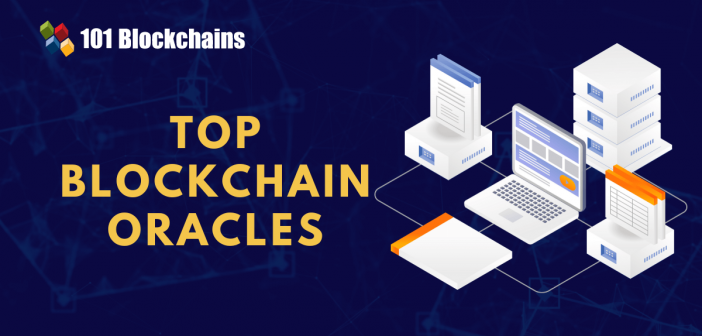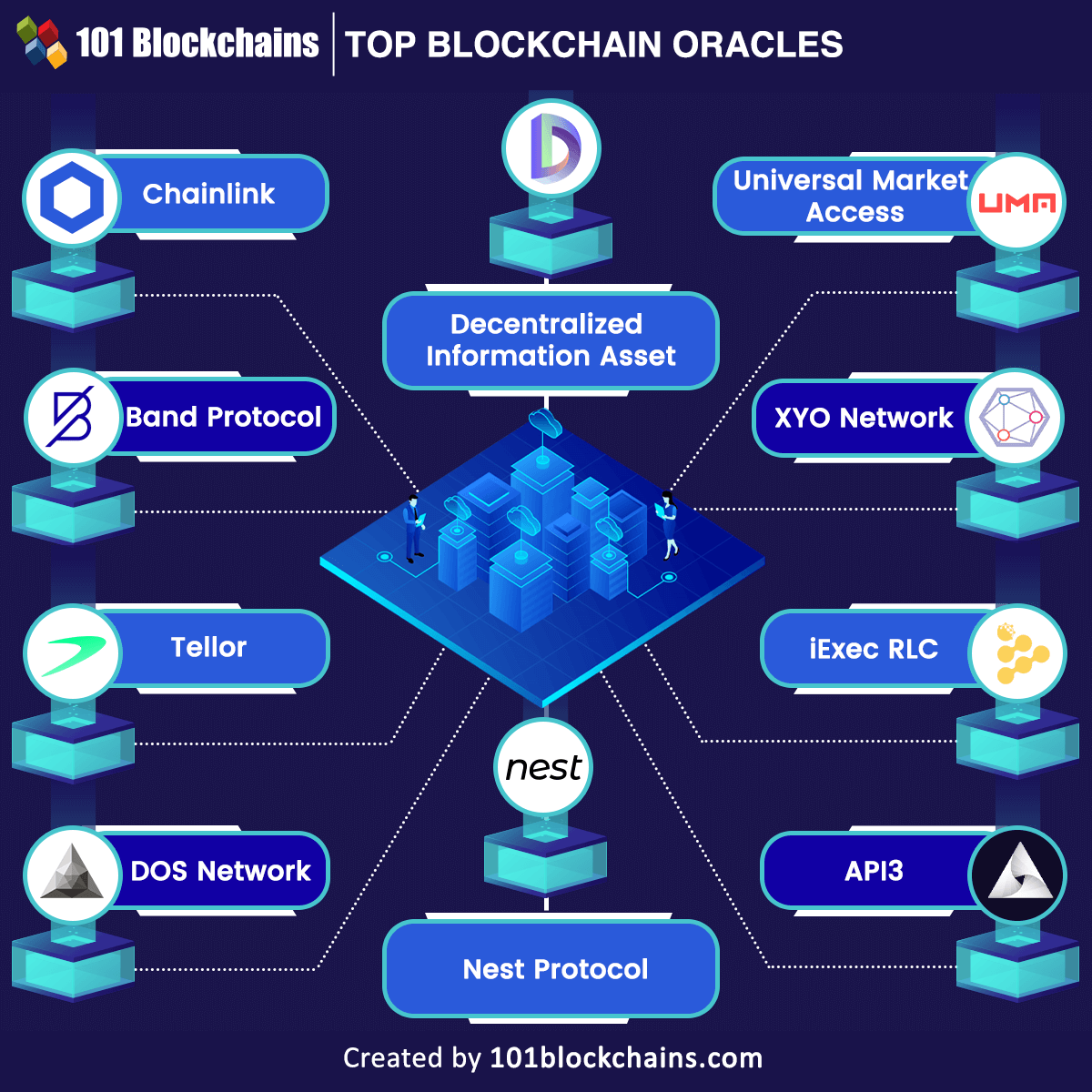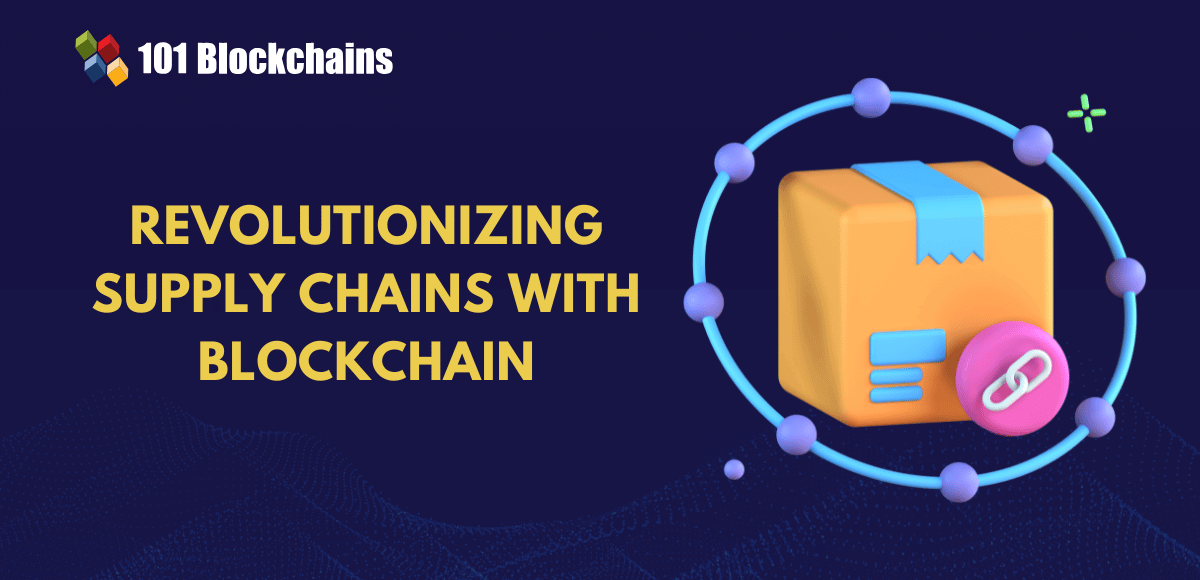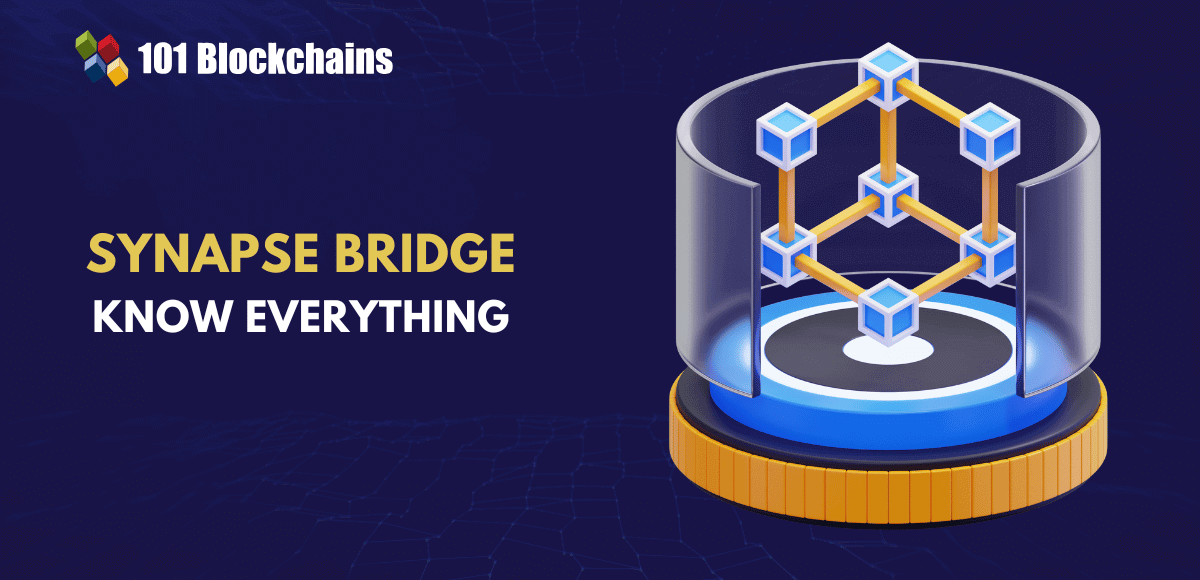Learn how blockchain truly works, master key definitions, and uncover what makes smart contracts so "smart." Dive into the fundamentals, gain valuable insights, and start your blockchain journey today!

- Blockchain
Georgia Weston
- on February 22, 2023
Top 10 Blockchain Oracles
Blockchain networks and smart contracts have resolved various concerns associated with centralized systems. However, blockchains cannot access important data from external sources. In some cases, smart contracts could need data inputs from external sources for executing a specific code. Therefore, top blockchain oracles have offered a viable solution to this problem of blockchain networks. Blockchain oracles are responsible for sending, executing, and verifying data obtained from external centralized sources before submitting the data to smart contracts.
One of the important highlights in the basics of blockchain oracles explained for beginners would focus on the ease of accessing reliable off-chain data. The reliability of data offers assured improvement in contract execution, and oracles obtain reliable data from various independent sources. Which blockchain oracle is the best choice in the market right now? You can find the answers followed by a list of popular blockchain oracles.
Build your identity as a certified blockchain expert with 101 Blockchains’ Blockchain Certifications designed to provide enhanced career prospects.
Importance of Blockchain Oracles
The first requirement for identifying effective blockchain oracles is the identification of their significance. You should know the answers to “How do blockchain oracles work?” alongside the different alternatives among blockchain oracles. Blockchain oracles are third-party platforms that bridge the gap between smart contracts and the external world.
Majority of blockchain oracles leverage network oracles for searching, querying, verifying, and retrieving real-world data for smart contracts which run decentralized applications or dApps.
On the other hand, certain types of blockchain oracles use API for reliable sourcing data from external platforms.
Smart contracts serve as integral blocks of the blockchain landscape. However, they are not ‘smart’ when it comes to the need for real-world data. Oracles provide the necessary information required to trigger smart contracts that would execute the desired transactions.
The data provided by oracles could include information from physical hardware, such as IoT, or software, such as Big Data applications. Oracles can provide different types of information, including temperature, price variations, data updates, and successful payment transactions.
The significance of each blockchain oracle example becomes clearly evident in the functionalities of different blockchain oracle variants. Depending on the function, blockchain oracles can be classified into different categories, such as software-based, hardware-based, inbound, outbound, or consensus-based oracles.
Software-based oracles rely on data from online sources, while hardware-based oracles rely on data from physical devices such as RFID sensors. Consensus-based oracles work on sourcing data validated through consensus, thereby setting the foundations for decentralized oracles.
Curious to understand the complete smart contract development lifecycle? Join Standard/Premium Plan and get free access to the Smart Contracts Development Course Now!
Most Popular Blockchain Oracles
The functionalities of blockchain oracles in ensuring efficient operations of smart contracts invite the need for identifying popular blockchain oracles. You can find a list of the best blockchain oracles confusing and ambiguous depending on your requirements. As multiple blockchain oracles compete to offer the best on-chain data reliability, developers and companies could experience significant challenges in choosing a blockchain oracle. Let us take a look at the features of some of the most popular blockchain oracles for 2023.

Please include attribution to 101blockchains.com with this graphic. <a href='https://101blockchains.com/blockchain-infographics/'> <img src='https://101blockchains.com/wp-content/uploads/2023/02/top-blockchain-oracles-1.png' alt='Top blockchain oracles='0' /> </a>
1. Chainlink
The foremost entry among renowned blockchain oracles is Chainlink, the largest blockchain oracle on the market. With a market capitalization crossing slightly over $1 billion, Chainlink is a strong player in the blockchain oracle space. Chainlink offers off-chain data to different blockchain-based solutions such as layer 1 blockchains, layer 2 solutions, dApps, and side-chains. The blockchain oracle was launched in 2019 with Ethereum as the foundation. It offers on-chain services to different blockchain platforms such as Compound, Avalanche, and Aave.
The reputation of Chainlink as a top blockchain oracle example is evident in the assurance of high security with its multi-platform functionalities. Chainlink relies on two formidable features, such as Chainlink Verified Random Function and Chainlink Automation. Chainlink Verified Random Function serves as a protocol for generating a set of random values alongside cryptographic proof of the values. The Chainlink VRF protocol supports smart contracts which involve unpredictable outcomes. The Chainlink Automation feature supports maintenance tasks for smart contracts.
Excited to learn the basic and advanced concepts of ethereum technology? Enroll Now in The Complete Ethereum Technology Course
2. Band Protocol
The list of popular blockchain oracles for 2023 would also include decentralized types of blockchain oracles, such as Band Protocol. It is a cross-chain oracle created on the Cosmos ecosystem, which includes many interoperable networks. Band protocol offers tamper-proof data feeds for smart contracts which use BandChain, the public blockchain of the protocol.
Validators on the BandChain blockchain place data requests through APIs or other web sources. Subsequently, the validators relay the data to entities and users. The protocol could send data to different blockchain networks on the basis of Inter-Blockchain Communication or IBC protocol of Cosmos.
The most significant highlight of the Band Protocol blockchain oracle explained in detail would focus on flexibility for creating custom oracle scripts. Users could create custom oracle scripts for receiving data streams from multiple external sources in the real world. Band Protocol leverages the Delegated Proof of Stake or DPoS consensus mechanism. Therefore, validators have to stake the native token, i.e., BAND, for retrieving data and voting on the authenticity of the data.
Get familiar with the terms related to blockchain with Blockchain Basics Flashcards.
3. Decentralized Information Asset
The next addition to the list of top blockchain oracles would point at Decentralized Information Asset or DIA. It is an open-source oracle platform tailored specifically for the DeFi landscape. DIA utilizes crypto-economic incentives for providing, sharing, and using transparent price data verified by multiple participants. The customizable data feeds help users in creating specific feeds through the configuration of methodologies and sources according to their needs.
Users can access the services of DIA oracle without any costs. The verification of price data for financial and digital assets through a community of stakeholders offers the assurance of data authenticity. On top of it, the scalability advantages of DIA ensure that it can maintain pace with the dynamics of the DeFi landscape. DIA offers oracle services for multiple blockchains, such as Ethereum, Fantom, Solana, Avalanche, Polygon, and Arbitrum.
Want to learn and understand the scope and purpose of DeFi? Enroll Now in Introduction to DeFi- Decentralized Finance Course
4. Universal Market Access
The effectiveness of Universal Market Access, or UMA, makes it one of the best blockchain oracles for developers. The Ethereum-based oracle offers smart contract templates to users for the creation of financial smart contracts and synthetic assets. Synthetic financial contracts are tokenized representations of real-world assets, such as derivatives. Synthetic financial contracts track the performance and pricing of derivatives through smart contracts. As a result, investors could find exposure in markets with higher barriers to entry.
The user-friendly platform of UMA is one of the foremost reasons to consider it as an alternative to blockchain oracles like Chainlink with advanced functionalities. Users could rely on UMA for the digitalization of existing financial products in the real world. The Universal Market Access oracle aims to bridge the gap between DeFi markets and the real world. On top of it, UMA is a completely decentralized and open-source oracle, thereby ensuring the integrity of sourced data.
5. XYO Network
The top examples of blockchain oracles also include entries like XYO network for a unique set of services. You don’t have to worry about queries like “How do blockchain oracles work?” when you have options like the XYO network. The Ethereum-based blockchain oracle protocol relies on a network of decentralized and anonymous devices for sourcing accurate information about the geospatial location of an individual or object. As a result, applications could conduct smart contract transactions, which need confirmation of location.
XYO Network leverages the proof-of-origin consensus algorithm, which utilizes the ‘bound witness’ interaction for confirming the locations of specific objects or people. The four important components of XYO network prove how different types of blockchain oracles have distinct architectures. XYO Network has four physical components, such as sentinels, bridges, diviners, and archivists, which perform distinct functions.
Sentinels serve as the location witnesses through ledgers for temporary solutions to heuristics. Bridges work on the interpretation of geospatial data, followed by transmitting the information from sentinels to archivists. Diviners are the devices used for analyzing methods for solving problems. Archivists help in storing the data from bridges and offering the data to diviners.
6. Tellor
Tellor is another prominent blockchain oracle example you can come across in the blockchain landscape right now. It is a permissionless oracle that offers access to off-chain data for dApps working across different industries. The origins of Tellor can be traced to Daxia, an Ethereum-based derivatives platform.
Tellor blockchain oracle utilizes a reporting client as the core element in its functions. The reporting client serves a system with a network of reporters. The reporters work on searching, querying, verifying and validating data. Tellor oracle protocol features two distinct types of data feeds Spot Price and Custom Price. Spot Price offers market data sourced from existing APIs, while Custom Price helps in data modification according to client requirements.
7. DOS Network
The other popular additions among top blockchain oracles also include DOS Network. It is a layer 2 decentralized oracle network that supports multiple mainstream blockchain networks. The most striking feature of a DOS Network is the assurance of access to real-time data feeds. As a result, it can help in connecting smart contracts and dApps to reliable data sources alongside the benefits of faster processing.
The speed of the DOS network in providing oracle data is a remarkable highlight for smart contract use cases which rely on urgency. DOS network can complete off-chain transactions within one second. On the contrary, the functionalities of the DOS network are restrained by performance factors of layer 1 protocols.
8. Nest Protocol
The Ethereum-based Nest protocol is another significant choice of blockchain oracles explained as a truly decentralized oracle. It leverages a reference system, known as quotation mining, to ensure accuracy in off-chain information. As a result, the Nest protocol could offer a straightforward oracle process with three distinct participants in the network. The network participants in the Nest protocol include price callers, miners, and verifiers.
Developers could leverage the Probabilistic Virtual Machine or PVM with Nest protocol. The virtual machine offers similar functionalities as EVM, with a library of basic functions alongside on-chain assets. Nest protocol uses the native NEST token for powering up the oracle’s ecosystem alongside offering economic incentives to network participants.
Start learning Blockchain with World’s first Blockchain Skill Paths with quality resources tailored by industry experts Now!
9. iExec RLC
iExec is another renowned choice among blockchain oracles for the DeFi sector. It offers a deviation from general responses to “How do blockchain oracles work?” with the marketplace for cloud computing services. The services are available on the iExec marketplace to help in connecting web2 apps and businesses with web3.
The DeFi oracle features a collection of user-friendly APIs which can help in creating custom oracles for web3 apps. In addition, users could also rent their computing services while maintaining ownership of concerned assets.
10. API3
The collection of best blockchain oracles also draws references to API3, a decentralized oracle for connecting web3 apps to off-chain data streams. API3 can help in sourcing data from different markets such as cryptocurrencies, stocks, and commodities. The most distinctive highlight of API3 refers to the use of decentralized APIs for direct data feeds from first-party sources.
Another significant feature in API3 refers to the web3 middleware, Airnode, which facilitates the direct connection of blockchain apps with web APIs. As a result, Airnode can ensure the compatibility of any API with blockchain technology. Examples of top blockchain networks using API3 include Polygon and Fantom.
Start learning Blockchain with World’s first Blockchain Career Paths with quality resources tailored by industry experts Now!
Final Words
The list of popular blockchain oracles showcases efficient choices for different blockchain-based projects. Blockchain oracles serve as bridges between the world of blockchain and the real world. As a matter of fact, the different types of blockchain oracles play a crucial role in the adoption of blockchain for real-world use cases.
Interestingly, the development of decentralized oracles also provides opportunities for using oracles in sensitive sectors such as DeFi. At the same time, blockchain oracles also strengthen the foundations of web3 with broader avenues for innovation. Learn more about blockchain oracles and their different real-world use cases.
*Disclaimer: The article should not be taken as, and is not intended to provide any investment advice. Claims made in this article do not constitute investment advice and should not be taken as such. 101 Blockchains shall not be responsible for any loss sustained by any person who relies on this article. Do your own research!






